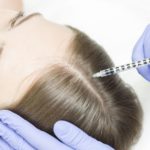All the articles in this blog are written in close collaboration with the doctors of our clinic specialized in the prevention and treatment of hair loss.

Baldness for women is becoming more and more widespread, but it is also affecting younger and younger women. Less common than in men, it is characterized by a loss of hair density. Caused mainly by hormonal disorders, the type of baldness at the origin of 95% of hair loss is androgenetic alopecia. Focus on female baldness.
What is baldness for women?
In order to better understand what baldness in women actually is, it is essential to first review the process of hair loss and the life span of the hair.
1 – The life cycle of the hair
The life cycle of a hair lasts 2 to 7 years. During its life, the hair will go through 3 stages:
- the anagenic phase.
During this first stage, which lasts from 2 to 7 years, the hair will grow. In other words, this is its growth phase.
- the catagenic phase.
During this second phase, which lasts 1 to 2 weeks, the hair stops growing or regresses.
- the telogen phase
Finally, during this third and last stage, which lasts from 5 weeks to 100 days, the hair finally falls out. This is the death of the hair.
When the scalp is healthy, 85% of the hair is in the growth phase and 10% is in the fall phase. This balance results in a daily hair loss of between 50 and 100 units. On the other hand, any hair loss greater than 100 hairs per day leads to baldness and alopecia.
Now let’s get to the heart of the matter.
Baldness in women is different from that in men. Indeed, it is most of the time diffuse, instead of balding a precise area such as the frontal line or the crown. Thus, the hair of a woman suffering from baldness becomes sparse and loses a lot of density and volume. However, this hair loss is never total.
This phenomenon is explained by the reduction in the duration of the anagen phase, the stage of hair growth. This greatly reduces its lifespan, which, by dint of decreasing, ends up exhausting its life cycle. Consequently, the more the stage of baldness in women advances, the higher the probability of seeing a bald area appear.
2 – The Ludwig scale to measure baldness in women
There is a scale to measure the progress of baldness in women: the Ludwig scale. Agnes Ludwig has classified baldness in 3 distinct stages, this scale concerns all the different types of women’s hair:
- stage 1: moderate alopecia: The amount of hair on the top of the head decreases. Thus, the hair remaining along the median line becomes thinner, shorter and sparser
- stage 2: more significant alopecia:
- stage 2-1 : the central line widens of 2 to 3 cm
- stage 2-2 : the top of the head is well lightened. On the other hand, some short hairs remain, it is also possible to see a downy hair appear. This stage generally appears after the menopause
- stage 3: almost total alopecia: the top of the head is 65% bald on average, so it is very difficult to hide the baldness with the rest of the hair, whatever the angle. The frontal line is also minimal because it measures less than 3cm

What are the different types of baldness in women?
Let’s look at the different types of baldness that can affect women.
1 – Baldness or androgenetic alopecia
The form of baldness that affects 95% of women, or more than 9 cases out of 10, is androgenetic alopecia. Androgenetic alopecia is caused by male hormones.
Good to know! Having androgenetic alopecia does not mean having a hormonal imbalance, but rather that the hair follicles are sensitive to male hormones, through the presence or absence of DHT.
In the female body, the adrenal glands and ovaries produce male hormones. Although they are present in smaller quantities than in men (about 20 times less), they are still necessary for the proper functioning of the female body.
Once the male hormones approach the hair follicles, they are converted into DHT (dihydrotestosterone) by an enzyme. It is at this crucial stage that baldness appears or not:
- either the hair follicle does not have DHT receptors, in which case DHT will not enter the hair and its life span will be normal and no baldness will appear because each hair will be replaced by a hair in the same good health
- or the hair follicle has DHT receptors, in which case the DHT can enter the hair and the activity of the hair’s life cycle will be disrupted. In particular, the proteins that regulate the life cycle of the hair will be affected. As a result, the life span of the hair will be reduced, the hair that falls out will be replaced by thinner, more fragile hair, until it does not grow back at all.
Baldness in women evolves much more slowly than baldness in men. However, when this condition affects a young woman, a few years will suffice for her hair to become thinner and bald, and its consequences will appear.
Unfortunately, there is no cure for this form of alopecia. However, it is possible to slow down its evolution. See the end of this article, in the section “baldness treatments”.
2 – Telogen effluvium
Telogen effluvium is also called diffuse alopecia, or hair loss without balding, because it is a massive loss of hair that affects the entire scalp. Patients may lose entire clumps of hair at a time. However, this form of baldness is reversible because it lasts from 2 to 4 months.
3 – Traction alopecia
Traction alopecia is known by different names: “bun alopecia”, “flight attendant syndrome”, etc. This form of baldness in women is particularly common in black women because it is caused by hairstyles that are traumatic for the hair roots:
- buns
- straightening
- very tight ponytails
- weaves
- too heavy braids
- extensions
- and so on
Thus, if the woman who uses these hairstyles does not stop quickly, the hair follicles will be irreversibly destroyed and consequently the hairline will recede by a few centimeters (about 5 cm).
Traction alopecia is characterized by hair loss in the frontal area and temples. In the most extreme cases, the entire scalp can be affected.

What are the causes of baldness in women?
Discover the various causes of baldness in women.
1 – Hormonal causes
The second cause of hair loss in women – after androgenetic alopecia – is hormonal: pregnancy, menopause, the change of seasons, etc. These are all factors that promote hair loss in women.
Pregnancy
From the 14th week of gestation, the proportion of hair in the anagen phase increases considerably. On the other hand, at the time of delivery, the quantity of hair in the telogen phase increases. Consequently, during the weeks following the delivery, an impressive loss of hair can appear.
It is only from the 4th month postpartum that the hair regains a normal growth rate.
Menopause
When the menopause begins, the female hormones disappear. As a result, hair grows back thinner and more fragile. In addition, their lifespan decreases drastically.
The change of season
The change of season can have an impact on hair loss. In fact, fall and spring are two seasons that favor hair loss. Fortunately, following this temporary period, hair grows back normally.
Various hormonal disturbances
- hyperandrogenism
The appearance of diffuse and severe alopecia should prompt any woman to carry out a hyperandrogenism assessment, especially if it is associated with other symptoms such as: hirsutism, acne and dysmenorrhea.
- the thyroid
A disorder of the thyroid gland can also cause hair loss. Indeed, its role is to produce hormones that regulate the entire metabolism of the body. Whether it is hyperthyroidism or hypothyroidism, it is preferable in all cases, in the presence of symptoms, to go to a specialist in order to carry out all the necessary tests.
2 – Drug treatments
Various drug treatments cause baldness, however chemotherapy is ranked number 1.
Chemotherapy
Although baldness caused by chemotherapy is totally reversible, it does cause a total and brutal loss of hair. The antimitotics used are the most severe treatments that cause baldness in women undergoing chemotherapy.
3 – Deficiencies cause baldness in women
Various nutritional deficiencies cause hair loss in women. These include iron, zinc, copper, folate, vitamins, etc. However, the two main deficiencies to avoid are iron and vitamin D.
Iron deficiency
Iron plays an essential role in the metabolism of red blood cells. One of the functions of red blood cells is to carry oxygen. Since women are prone to blood loss during menstruation and pregnancy, iron deficiency is more common than in men.
If the basal cells of the hair are poorly oxygenated, they will have difficulty duplicating. Consequently, keratin production will be affected. So you can see how essential the role of iron is. And how an iron deficiency can not only have a negative effect on hair growth and development, but also aggravate baldness in women.
Vitamin D deficiency
Vitamin D comes from two sources:
- on one hand, it is synthesized by the body following exposure to the sun
- on the other hand, it is provided by food and/or vitamin D supplementation
Vitamin D deficiency causes premature aging of hair follicles. This results in a first step of hair loss. In a second phase, hair renewal is less effective.
4 – Stress: a factor that aggravates baldness in women
Stress is one of the factors that aggravate hair loss, and thus causes baldness in women as well as in men.
Stress stimulates the adrenal glands that produce male hormones. As a result, the production of DHT (as we have previously seen with androgenetic alopecia) will increase and attack the proteins that regulate the life cycle of hair. And ultimately, baldness in stressed women develops.
What are the treatments for baldness in women?
Fortunately, there are treatments to cure baldness:
- adopt a balanced diet, rich in vitamins and minerals
- medication
- injections
- light therapy
- hair transplants
What you should know about baldness in women
Female pattern baldness is a partial and diffuse loss of hair, thus the life cycle of the hair is reduced.
Female pattern baldness is measured with the Ludwig scale in order to define the stage of the condition.
There are different forms of female pattern baldness, however, the main one – which affects more than 9 out of 10 women – is androgenetic alopecia.
The main cause of alopecia in women is hormonal. However, other factors can be at the origin of this condition, in particular deficiencies and various medicamentous treatments, without forgetting the evil of the century: stress!
However, baldness is not a fatality; it is possible to remedy it. There are several avenues to explore, but it is important to identify the type of baldness beforehand. However, it is important to identify the type of baldness beforehand in order to choose the most appropriate treatment. A consultation with a hair loss specialist is essential.
You can reach us via the contact form, our team of specialists will answer all your questions with great pleasure and will put their greatest expertise at your service, so that you can overcome your hair loss problems.

Did you like this article? Are you looking for solutions to treat your baldness in Brussels? Discover our hair transplant method and contact us at +32-4731-379-19 or via the form on the website to receive a free diagnosis!







